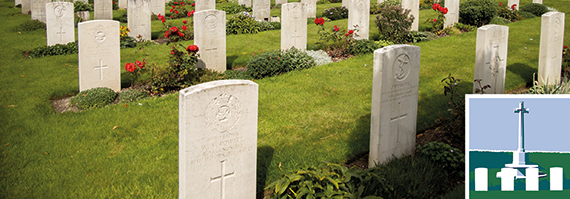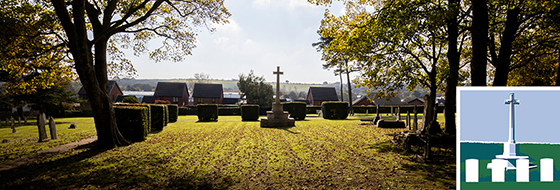Brecon Cemetery
Visit the largest group of war graves in this part of Mid Wales in Brecon Cemetery. Thirteen servicemen of the First World War and eleven of the Second lie here, most of them under the familiar CWGC pattern headstone. They are scattered throughout the cemetery – all except one group of eight. What is their story?
![]()
Lying on the northern edge of the Brecon Beacons, the market town of Brecon was the county town of Brecknockshire until 1974. In Brecknockshire, as was, the CWGC commemorates over 180 servicemen and women across 51 sites, most of which have fewer than five war graves. Brecon Cemetery has the largest number in one place, with 24. Two thirds of the servicemen buried here came from local families, or via the town’s military connections. But the war cemetery’s only war graves plot is not made up of South Wales Borderers, or men from other Welsh units – far from it. A carefully maintained hedge surrounds the graves of eight men who are far from their mountain homes in the north-western frontier of pre-Partition India, here in the mountains of Wales.
Find out more about the history of this cemetery
On the heights above the north bank of the Usk, looking towards the peaks of the Brecon Beacons, lies Brecon Cemetery. It was opened in 1858. Brecon has long been associated with the British Army: the first barracks were built in 1805 and from 1873 they were the depot for the 24th Regiment of Foot. This regiment was renamed the South Wales Borderers in 1881, the name it carried through the First and Second World Wars, and Brecon remained its depot. During the First World War, most of the regiment’s war-time expansion battalions were formed here before training here and elsewhere and then serving at home and overseas in France and Belgium, at Gallipoli, in Egypt, Mesopotamia and the Salonika Campaign.

South Wales Borderers on the road to the trenches at Montauban, Somme, in the rain. October 1916. © IWM Q 5320
Most of the Borderer’s dead are buried or named on CWGC memorials far from home, but six of the 13 First World War graves here at Brecon are of men from that unit. The first was Private Michael Mines, of Co. Kilkenny, Ireland, who died in the military hospital within the barracks at Brecon in February 1915, of broncho-pneumonia. He was joined by Corporal Richard Hooper, a pre-war regular soldier with the Borderers, whose wife and son were living in Brecon in 1911 and brought his body home from the military hospital in Fazakerley, Liverpool, in June 1915.
Five more servicemen with a family connection to Brecon would be buried here by 1921, including Serjeant William C. Turner of the Royal Flying Corps, killed in a crash while learning to fly at Rendcomb Aerodrome, Cirencester. Some of those who died while serving in the Brecon area were buried here too.
While the First World War left behind CWGC headstones here bearing names like Evans, Thomas, Davies and Williams, in 1941-42, they would be joined by men called Ali and Muhammad. In 1939 British Army planners realised the now completely mechanised army might need some form of animal transport. The best military animal transport available was in the British Indian Army, where it was necessary for areas like the north-west frontier.

Mules working over rocky terrain. IWM H 5568
Four Royal Indian Army Service Corps (RIASC) animal transport companies and their support units, called Force K6, arrived in France in December 1939, where their off-road capabilities were welcomed. One of the four companies were captured while supporting the rear-guard action that protected the evacuation at Dunkirk. The other three made it out, but were forced to leave all their animals behind. In the UK they were re-equipped and deployed to support and participate in mountain warfare training in Wales.

Mule handlers of the RIASC on formal parade, November 1940. © IWM H 5584

The 31st Independent Infantry Brigade trains with mule teams in the Black Mountains, Wales, June 1941 © IWM H 11151
RIASC companies were dispersed around the Brecon Beacons in 1941; in early 1942 some RIASC units moved to Snowdonia to support training exercises there. In June-July 1942, Force K6 left the mountains of Wales for those of Scotland, leaving behind eight of their comrades in a beautiful corner of Brecon Cemetery. All of these men had served in mule companies, most as drivers. Their average age was 25, and three had wives awaiting their return. The first to be buried here was Muhammad Sarwar of Shahpur in June 1941; the last, Muhammad Din of Gujrat, son of an Imam, in July 1942. All were carefully buried in accordance with Muslim practices. While they may be far from home, they are not forgotten.
Visit Brecon Cemetery
Access to the cemetery is from Cradoc Road, limited parking is available on site.
Before visiting we recommend you consult the website of the cemetery authority:

Opened in 1859, this is the final resting place of over 700 Commonwealth and Allied servicemen and women of the two world wars.
Cardiff Cathays Cemetery
Amongst the many thousands of civilian burials here are 254 Commonwealth War Graves, 158 from the First World War and 96 from the Second.
Gloucester Old Cemetery
This example of a grand Victorian garden cemetery is where the CWGC commemorates more war dead than anywhere else in Bristol. Many were buried by their next of kin, but others are far from home indeed
Bristol (Arnos Vale) Cemetery
Owned by the MOD but cared for by the CWGC, come and visit a century’s graves of men of the army, navy and air force. Forty are First World War graves, while 33 were buried here between 1939-1947.
Pembroke Dock Military Cemetery




